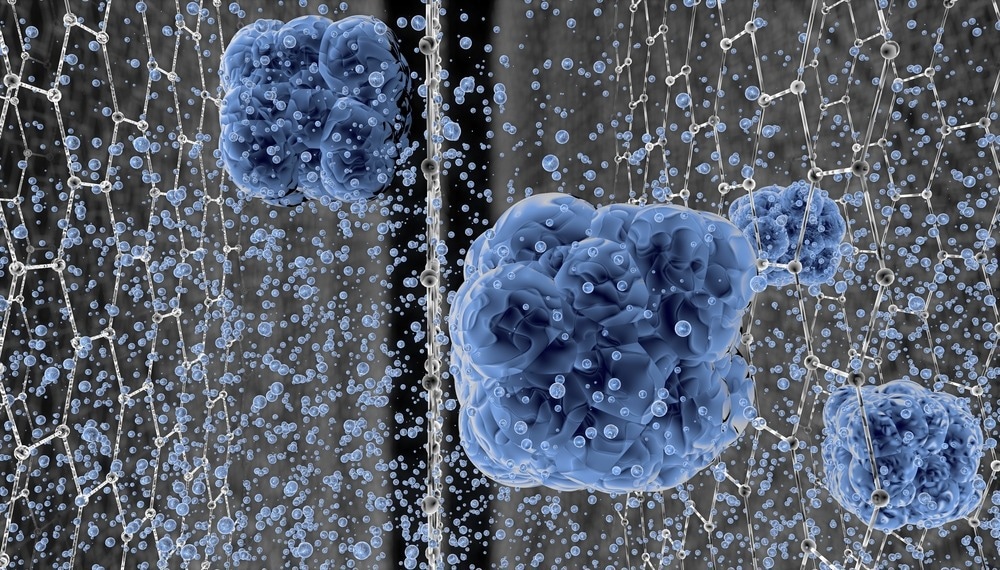Malachite green (MG) is a cationic dye frequently used as a dye in the fish farming, food, biomedical, and oil industries. However, malachite green has a high cytotoxic activity, making it an extremely dangerous substance for a sustainable ecosystem.

Study: Comparative removal of hazardous cationic dyes by MOF-5 and modified graphene oxide. Image Credit: Angel Soler Gollonet/Shutterstock.com
Therefore, the timely removal of malachite green is critical for maintaining a green ecosystem and the required public health standards.
A recent study published in the journal Scientific Reports focuses on this issue by exploring metal-organic frameworks (MOF-5) and reduced graphene oxide as potential absorbers for malachite green extraction and removal.
Malachite Green (MG): A Harmful Cationic Dye
Cationic dyes, such as malachite green, are widely used in a variety of industries. The textile industry is the largest consumer of cationic dye products among a wide range of industries.
The useful dye consumption is typically low due to the minimal attachment rate and approximately 50% of dye materials are typically discarded as wastewater. Malachite green's low degradation rate and heteroaromatic structure inhibit efficient microbial degradation in industrial wastewater filtration.
Cationic dyes are easily visible, as the names suggest. Their existence in aquatic habitats is not only visually unappealing but also influences the environment due to their toxic effects on marine life and interference with the photosynthesis process.
Malachite green, like other cationic dyes, is used in fish farming, food, health, and pharmaceutical industries because of its impressive anti-parasitic characteristics. Several recent studies, however, have found that consuming malachite green has a detrimental effect on the DNA of animals and plants.
Adsorption as an Optimum Method for Malachite Green Removal
Malachite green is extremely toxic, cancerous, and genotoxic, and hence must be removed from sewage before release. Different methods such as photoreduction, biochemical pathways, membrane separation, and adsorption are used for effluent treatment and cationic dye intensity reduction before discharge to the environment.
Adsorption is a popular method for removing malachite green because it offers multiple benefits over other techniques. It is an intriguing and flexible option due to its simple operation and design, innocuous nature, and high performance at low pollutant concentrations.
Many studies have been carried out in recent years to create novel adsorbents with unique properties for environmental protection.
MOF-5 and Graphene Oxide: Ideal Adsorbents for MG Removal
Metal-organic frameworks (MOFs) are a unique type of highly permeable substances made up of both inorganic and biological elements. MOFs have a large internal interfacial area and pore volume and are crystalline in nature.
MOF-5 is a well-known metal-organic framework because of its unique permeability and heat resistance. MOF-5 is made of three-dimensional subgroups of terephthalic acid and zinc oxide. Moreover, they are highly controllable in terms of design and functionality, making them optimal adsorbents for malachite green separation.
Graphene oxide (GO) is a configurable graphene derivate with highly functional groups like carboxyl, hydroxyl, and epoxy. Reduced graphene oxide (RGO) is another graphene derivative with a high wettability and an abundance of hydroxyl functional groups.
The graphene oxide family is suitable for treatment processes such as adsorption, membrane filtration, electrochemical treatment, and dialysis due to the existence of functional groups and its high versatility and adaptability. Therefore, MOF-5 and reduced graphene oxide can be used as suitable adsorbents for malachite green removal from industrial wastewater.
Highlights and Key Developments of the Current Study
This study aimed to compare the dye adsorption characteristics of MOF-5, a hybrid framework, and reduced graphene oxide, a carbonaceous substance. The researchers started by performing a comparative study to see how different adsorption specifications affected the performance of MOF-5 and reduced graphene oxide.
The effects of operating factors such as pH, amount of adsorbent, malachite green accumulation, and diffusion coefficient were then investigated. The stability of the adsorption system was also studied to understand the adsorption process and correlate the adsorption capability of the materials used.
Both MOF-5 and reduced graphene oxide performed admirably in terms of malachite green removal. However, reduced graphene oxide outperformed MOF-5 in malachite green adsorption, with a 7.2 times higher kinetic rate and 21 times higher adsorption capability.
The comparative analysis presented in this study clearly shows that metal-organic frameworks like MOF-5 and carbonaceous materials like reduced graphene oxide have excellent potential for removing harmful environmental pollutants.
Reference
Mohammadi, A. A. et al. (2022). Comparative removal of hazardous cationic dyes by MOF-5 and modified graphene oxide. Scientific Reports. Available at: https://doi.org/10.1038/s41598-022-19550-5
Disclaimer: The views expressed here are those of the author expressed in their private capacity and do not necessarily represent the views of AZoM.com Limited T/A AZoNetwork the owner and operator of this website. This disclaimer forms part of the Terms and conditions of use of this website.